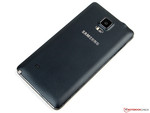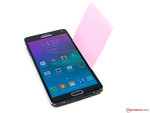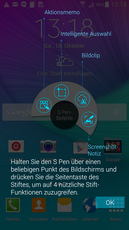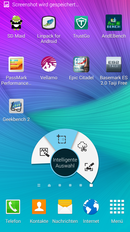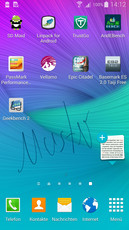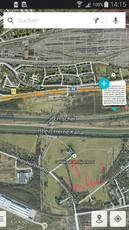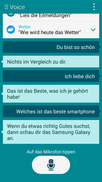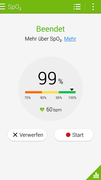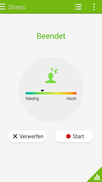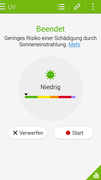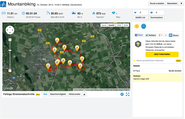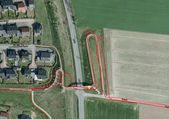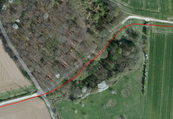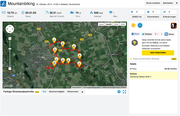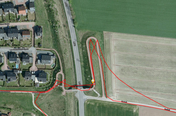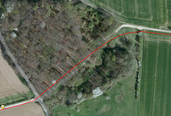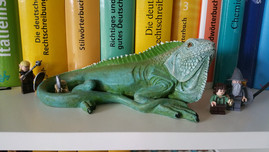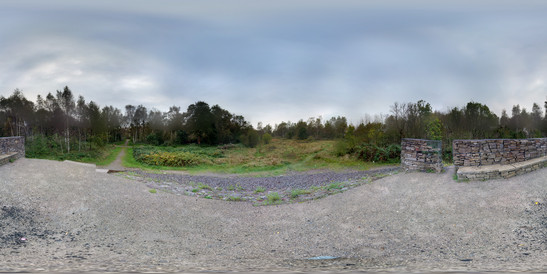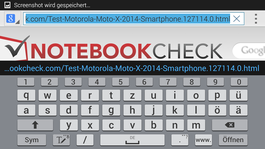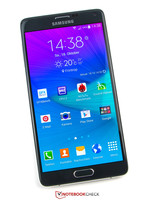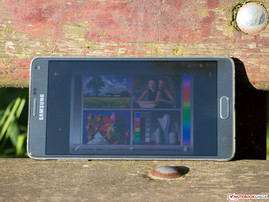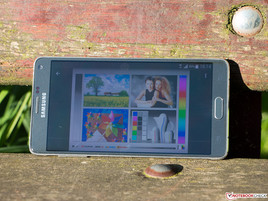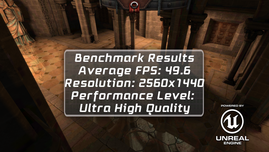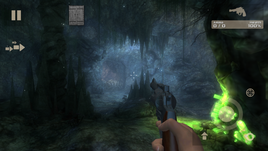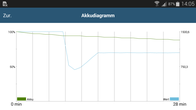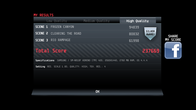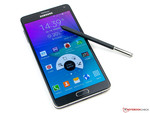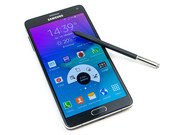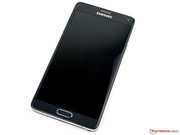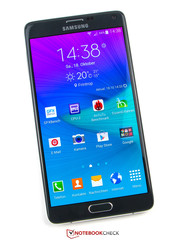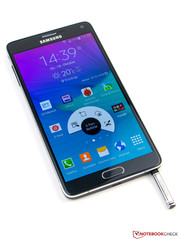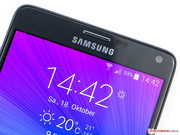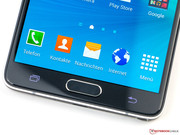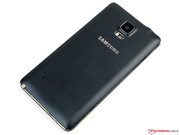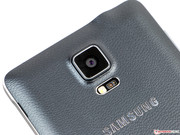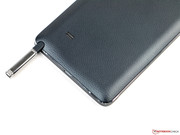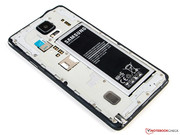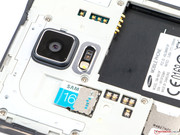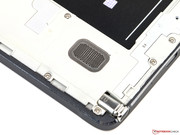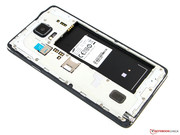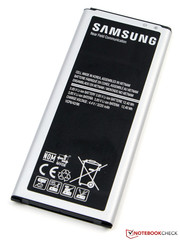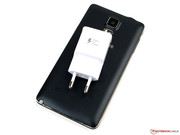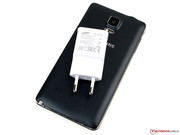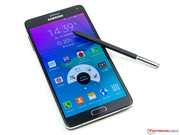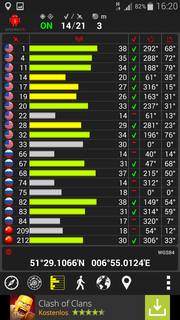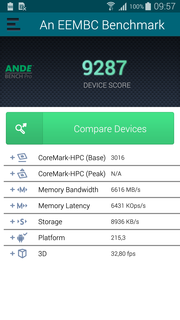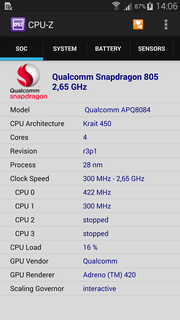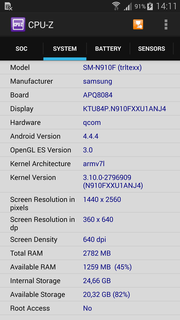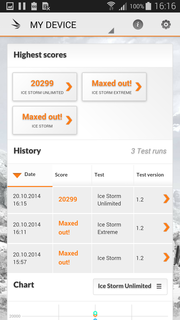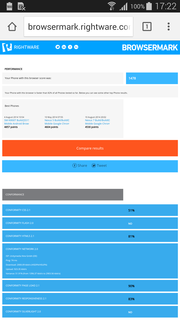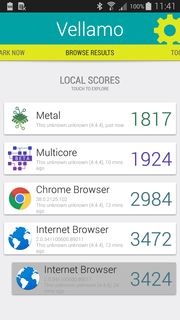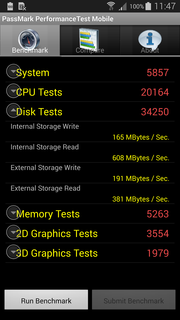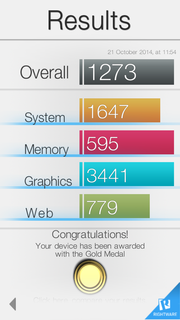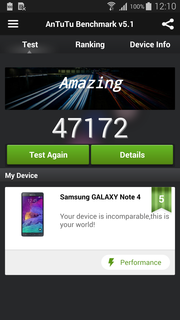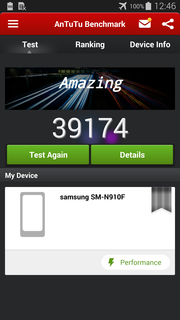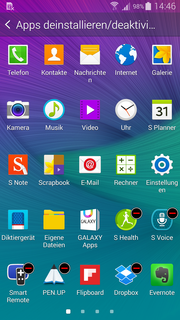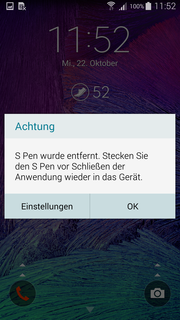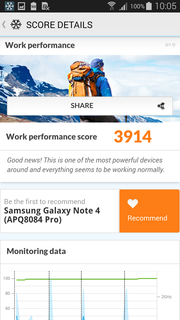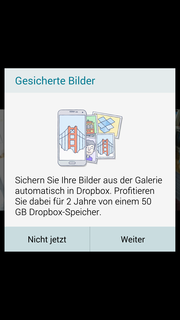Samsung Galaxy Note 4 (SM-N910F) Smartphone Review

For the original German review, see here.
The Samsung Galaxy Note 4 is the latest upgrade of the flagship smartphone with a digitizer from the South Korean manufacturer. Besides the current Snapdragon 805 processor there is also a higher resolution display with a higher pixel density. But Samsung also improved the build quality and uses a metal frame for the first time, so the device is not only an upgrade in terms of performance but also in terms of materials. The S-Pen was reworked as well and is supposed to have more pressure levels. Only the USB port is a step down. This time it only supports the 2.0 standard, while the Note 3 still had a USB 3.0 port.
There are currently not many devices that could keep up with the Galaxy Note 4 in terms of specifications. Samsung is also still the only manufacturer that offers such high-end smartphones with additional digitizers. The South Koreans charge quite a lot as well, the RRP is hefty at 769 Euros (~$960) and therefore 20 Euros (~$25) higher compared to the predecessor. Can the smartphone fulfill its promises?
None of the rivals have digitizers but are otherwise among the most powerful devices on the market. The list includes the LG G3, Sony Xperia Z3, HTC One M8, Apple iPhone 6 Plus, Nokia Lumia 1520 as well as the Huawei Ascend Mate 7.
Case
The case of the Samsung Galaxy Note 4 is now a bit thinner but also a bit longer in return. Despite the large 5.7-inch screen, the device feels good in the hand and is not too heavy with 176 grams. The slightly higher weight compared to the Note 3 (168 grams) is probably a result of the metal frame. However, the latter improves the quality impression of the smartphone significantly, so we have no problems with a couple of grams more.
The build quality is on a very high level. The gaps are even, but the gap between the display glass and the metal frame could actually be a bit smaller. Some gap-gate scenarios show that you can insert thick business cards, but we cannot confirm this. Sure, there can be more dirt than usual, but we could only clamp a thin piece of paper with a lot of patience and we could only insert it by a millimeter. Samsung could have done a better job, but this is not a serious issue.
The Galaxy Note 4 is completely resistant against pressure and also very torsion-resistant. The plastic back cover has a leather design and can be removed. Under the cover are the replaceable battery and the slots for the micro-SIM and memory card. The device is, unfortunately, neither dust-resistant nor waterproof.
Connectivity
The Galaxy Note 3 had a USB 3.0 port, but the Note 4 only supports the slower USB 2.0 standard. The port is used for data transfers with a computer and to recharge the smartphone. It also supports OTG and MHL.
The microSD slot supports memory cards with a capacity of up to 128 GB. It can be used to store media files and also apps. You get support for App2SD, so the apps can be launched from the card as well.
Our review unit does not support the streaming standard DLNA, but Wireless Display or Miracast, respectively, in return. This is unfortunate since most TVs, Blu-ray and DVD players support DLNA, while Miracast usually requires an additional adaptor.
An infrared transmitter is available as well and allows the control of TVs, set top boxes, Blu-ray and DVD players as well as AV receivers. Inputs are quickly executed in combination with the app Smart Remote.
Software
The operating system of the Samsung Galaxy Note 4 is Google Android 4.4.4 KitKat with the customized TouchWiz user interface. An update to Android 5.0 Lollipop is pretty likely, especially since the manufacturer already made a small announcement on its Twitter channel.
Anyway you look at it, the #GALAXYNote4 Quad HD Super AMOLED display is pretty sweet. #NoteTheDifference pic.twitter.com/8JsfYyzLs7
— Samsung Mobile (@SamsungMobile) 21. Oktober 2014Otherwise, the software is pretty similar to the Galaxy S5, the only addition are the features for the S-Pen. They did not really change compared to the predecessor but are pretty handy. Screenshots can immediately be processed, shared or saved, respectively. The same applies for sections of the screen, and texts can be highlighted with the Intelligent Selection. The latter can directly be stored with the corresponding source information in Scrapbook. It is also possible to select the text in the screenshot later and copy it into a text processing program. Simple notes are possible with ActionMemo.
The voice recognition S Voice is also available and works quite well. Samsung only installed a robot-like voice to reduce the storage requirements for the voice recognition. If you want to use S Voice, you can download a better quality pack (around 124 MB) from the Galaxy Store for free. The situation is similar for the S Translator, the language packs can be installed afterwards if you need them. Multi Window is Samsung's multitasking feature for the Note 4, which we already know from other devices. This also works well in the case of our review device and does not cause any criticism. However, we can sometimes notice micro stutters. Google's Android 5.0 should improve the situation, but Samsung will have to optimize its own user interface as well.
S Health is now available in version 3.0 and leaves a good impression. Only the hourly reminders about your own inactivity are a bit annoying. The sensor at the back of the Samsung Galaxy Note 4 can be used to determine your heart rate and also for your own oxygen level. It is also possible to direct the sensor towards the sun to determine the level of the UV radiation.
Samsung installs a lot of third-party apps. Most of them can be deleted without problems, but this is not the case for Flipnote and Evernote, which cannot be uninstalled.
Communication & GPS
The WLAN module of the Samsung Galaxy Note 4 supports the IEEE 802.11 standards a/b/g/n/ac in 2.4 as well as 5 GHz networks. The range is good. The damping in direct proximity to the router (Fritz!Box 6360) is around -50 dBm in a 2.4 GHz network, and between -73 and -79 dBm with a distance of 20 meters. The smartphone indicated an average signal quality. Websites are still loaded very quickly, only the ping times were sometimes quite high. The damping was a bit lower in a 5 GHz network.
Access to mobile Internet is possible via quad-band HSPA+ with download rates of up to 42 Mbps. Faster connections are supported by LTE Cat. 6, which provides download speeds of up to 300 Mbps (upstream up to 50 Mbps). The coverage of frequencies is very good, but there are, unfortunately, no corresponding networks in Germany yet.
We have to praise the integration of Bluetooth 4.1, especially in combination with LTE Advanced, since the new standard reduces interferences in the 2,600 MHz band in particular. It is also possible to manage more connected devices at the same time. We had no problems to stream music or the sound of an HD video stream from the Internet.
You can locate the position of the Samsung Galaxy Note 4 via GPS, Glonass or Beidou. In theory, the Snapdragon 805 SoC already supports the European Galileo system, but the start was delayed to 2020 because of numerous problems. The satellite fix was very quick outdoors, but it can take a bit longer indoors.
We checked the accuracy of the position in a comparison with the Garmin Edge 500 bicycle computer. Overall, the Note 4 manages a good result and only deviates by 4% from the reference device. Especially the narrow sections reveal some problems, but problematic situations like the forest are not a big challenge.
Telephone Functions & Voice Quality
The phone app is pretty much standard, only the design was slightly changed. However, Samsung expanded the handling with some useful functions. Swiping from the right over a contact in the call list automatically opens the messages. Swipe from the left and you automatically call the contact.
The voice quality is pretty good. The recipient confirmed a very good quality when we held the Galaxy Note 4 to the ear, but there was a slight clattering on our side. The quality via speaker is decent as well and the sound output of the smartphone is okay. The provided headset leaves a good impression; only high tones were a bit shrill.
Cameras
Even the front camera of the Samsung Galaxy Note 4 is a small highlight. It takes pictures with up to 3.7 MP (2560x1440 pixels, 16:9) and captures a lot of light (aperture f/1.9). You can also use the heart-rate monitor at the back of the smartphone as a trigger in the Selfie mode, which makes the handling very simple. There is a special Groufie mode as well, which almost works like the Panorama mode and uses swings to capture a wider angle. The whole picture is then created from three pictures, which have a pretty low resolution of just 1.6 MP (1365x1141 pixels).
The main camera is, under good lighting conditions in particular, one of the better modules on the market. It takes pictures with up to 15.9 MP (5312x2988 pixels, 16:9) and is supported by an LED flash. However, the auto feature of the flash could be better and activates the flash pretty late. The picture is conveniently sharp and details are very stable as well. The color reproduction is also good. Because of the large aperture (f/2.2) there is a slight overexposure, even though it is only visible with close objects.
Colors appear a bit pale in worse lighting conditions and the contours are a bit blurry. Picture noise is visible, which is also a result of the mediocre light sensitivity (up to ISO 800). You can still take decent pictures in combination with the flash, especially since the latter still allows pretty natural colors.
Videos on the Note 4 can be recorded in Ultra HD (3840x2160 pixels, 30 fps). If you prefer Full HD, then you get twice the frame rate, so the material is also well suited for high-quality slow-motion videos, even though the slowing factor is limited. The special slow-motion mode supports up to 120 fps, but the videos are immediately compressed to the final result on the smartphone and are only available in 720p (14 fps). There is also no sound in slow-motion videos. Sound is otherwise recorded in stereo and the quality is comparatively good.
Accessories
The provided accessories of the Samsung Galaxy Note 4 include a modular quick-charging power adaptor with a nominal output of 15 (9 Volts, 1.67 Amps) or 10 Watts (5 Volts, 2 Amps), respectively. You also get a data cable, a quick-start guide, a headset as well as a small tool to change the SIM and SD cards.
Optional accessories from the manufacturer consist of different kind of covers. The charging cover EP-VN910I (RRP 60 Euros, ~$75) is made of leather and not only protects the smartphone, but it can also be used to charge the battery wirelessly via induction. Slightly less exclusive is the inductive charging set EP-WN910I for the same price, which includes a corresponding charging plate. The back cover (RRP 20 Euros, ~$25) of the smartphone is available in several colors (white, anthracite, gold, pink) as well.
Warranty
Samsung grants a warranty of 24 months for the Galaxy Note 4; the provided accessories and the battery are covered for six months.
Input Devices & Handling
The main input device of the Samsung Galaxy Note 4 is the 5.7-inch capacitive touchscreen, which recognizes up to ten inputs simultaneously. The panel is protected by a layer of Corning's Gorilla Glass 3, which provides great gliding capabilities that don't cause any criticism. The touchscreen executes inputs quickly and very precisely.
The keyboard layout of the smartphone is similar to the Galaxy S5 and is just slightly bigger. The layout is good and enables quick inputs. However, it does not use all of the available space at the peripheral areas in landscape mode. The review unit has many options to improve the handling of the smartphone with one hand, but don't be fooled, the smartphone should be operated with two hands.
The S-Pen works as usual and was once again improved compared to the predecessor. The digitizer can now differ between 2048 pressure levels, which is twice as much as before. You can select that the display only accepts pen inputs to avoid accidental inputs from the hand. Text or symbol inputs should work well with the S-Pen, only the shape of the pen could be better from an ergonomic point of view.
Voice inputs are possible via S Voice or Google Now; both scenarios work pretty well, but, contrary to the Moto X, this is not possible in standby. However, it is possible to adjust the proximity sensor of the Note 4 so that it still works with a deactivated display and activates the latter with a contactless hand gesture.
Display
The display of the Samsung Galaxy Note 4 measures 5.7-inches and is therefore just as big as its predecessor Galaxy Note 3, but the resolution has been increased. The manufacturer equips its high-end smartphone with a QHD Super AMOLED panel with 2560x1440 pixels. This means you get a screen ratio of 16:9 and an enormous pixel density of 515 PPI, so you cannot see individual pixels.
We determined the maximum brightness with the manual selection of the highest luminance setting. The test device manages a good result of up to 356 cd/m² and the brightness distribution is very good with 92%. However, every other device within the competition is brighter in this situation. They all use LCD displays, which are brighter in general to compensate for the lower contrast. But the Galaxy Note 4 can double its brightness if you activate the brightness sensor. In this case we can record up to 750 cd/m². We cannot reproduce this effect with a flashlight, so we weren't able to record an objective result. We awarded three additional points for this exceptional luminance in the display rating.
| |||||||||||||||||||||||||
Brightness Distribution: 92 %
Center on Battery: 335 cd/m²
Contrast: ∞:1 (Black: 0 cd/m²)
ΔE ColorChecker Calman: 1.77 | ∀{0.5-29.43 Ø4.78}
ΔE Greyscale Calman: 2.06 | ∀{0.09-98 Ø5}
99% AdobeRGB 1998 (Argyll 1.6.3 3D)
Gamma: 2.41
CCT: 6424 K
| Samsung Galaxy Note 4 Adreno 420, 805 APQ8084, 32 GB eMMC Flash | Apple iPhone 6 Plus PowerVR GX6450, A8, 64 GB eMMC Flash | LG G3 Adreno 330, 801 MSM8974AC, 16 GB eMMC Flash | Nokia Lumia 1520 Adreno 330, 800 MSM8974, 32 GB eMMC Flash | Sony Xperia Z3 Adreno 330, 801 MSM8974AC, 16 GB eMMC Flash | |
|---|---|---|---|---|---|
| Screen | -18% | -66% | -12% | -113% | |
| Brightness middle (cd/m²) | 335 | 519 55% | 417 24% | 421 26% | 702 110% |
| Brightness (cd/m²) | 339 | 496 46% | 395 17% | 399 18% | 671 98% |
| Brightness Distribution (%) | 92 | 90 -2% | 89 -3% | 86 -7% | 90 -2% |
| Black Level * (cd/m²) | 0.62 | 0.96 | 0.48 | 0.72 | |
| Colorchecker dE 2000 * | 1.77 | 3.67 -107% | 5.67 -220% | 3.28 -85% | 8.92 -404% |
| Greyscale dE 2000 * | 2.06 | 3.78 -83% | 5.66 -175% | 2.28 -11% | 9.59 -366% |
| Gamma | 2.41 91% | 2.42 91% | 2.53 87% | 2.5 88% | 2.75 80% |
| CCT | 6424 101% | 7327 89% | 7741 84% | 6936 94% | 9408 69% |
| Color Space (Percent of AdobeRGB 1998) (%) | 99 | 59 -40% | |||
| Contrast (:1) | 837 | 434 | 877 | 975 |
* ... smaller is better
Because of the Super AMOLED technology in the Galaxy Note 4, black is really deep black. This means 0.0 cd/m² in our measurements and an infinite contrast ratio. All the rivals use IPS panels, so their results are worse.
The color production of the review unit sets new reference values and covers the Adobe RGB color space by 99%. You can choose between three modes. Simple shows the colors as natural as possible, so you lose the typical overexposure of the colors due to the OLED. The presentation is free of visible color distortions and can actually satisfy professional users. The accuracy is still very good in the mode Photo, but the saturation of the colors is slightly higher to ensure a more brilliant picture. The Cinema mode has even stronger colors and a visible blue cast. Without a manual selection, the smartphone adjusts the picture to compatible apps to ensure the best possible result all the time.
We are positively surprised by the Samsung Galaxy Note 4 outdoors. While the Lumia 1520 manages a good visibility under sunlight via software algorithms, the Note 4 does it with raw luminance. If you activate the brightness sensor, you will be surprised by the maximum brightness of the review device. This means it is no problem to read the display content even under bright sunlight. This works really well in practice, especially since the reflections from the glass surface are not too bad.
The viewing-angle stability of the Samsung Galaxy Note 4 is very good. Content is easy to read on the Super AMOLED display, even from very flat angles, and we cannot see a ghost effect, either. However, there is a slight green cast a soon as the angle gets bigger than 100 degrees. Reflections from the glossy surface of the Gorilla glass are not as bad compared to other devices and there is hardly any brightness reduction with flat angles, either.
Performance
The Samsung Galaxy Note 4 (SM-N910F) currently uses the fastest SoC from the manufacturer Qualcomm. The Snapdragon 805 AQP8084 (32-bit) processor has four cores with a clock of up to 2.7 GHz. It is supported by 3 GB memory, so the system performance is really good. Graphics calculations are handled by the integrated Qualcomm Adreno 420, which runs with up to 600 MHz. The GPU supports both OpenGL ES 3.1 as well as DirectX 11.2. There is also another version of the Note 4 (SM-910C) that is equipped with a Samsung processor. The Exynos 5433 has eight cores and already supports 64-bit. This could be a big advantage with the upcoming update to Android Lollipop 5.0 since the operating system will support 64-bit processors. However, we currently don't know if the 64-bit functionality of the Exynos can be activated with an update.
The benchmark results of the Note 4 are very good, even though it cannot compete with the performance of the iPhone 6 Plus or the Shield Tablet, which uses the Tegra K1. The review unit leaves a good impression in terms of raw CPU performance. Compared to smartphones with the predecessor SoC Snapdragon 801 we can see a CPU performance improvement of up to 12% in the Passmark CPU test. Linpack shows a similar picture, while the difference is bigger in the 3DMark Physics test, where the Note 4 can utilize its multi-core performance. In this case, only the Tegra K1 SoC is faster, but even the processor from Apple is clearly beaten. The Snapdragon 805 is twice as fast as the A8 from Apple and around 40% faster than the Snapdragon 801 inside the Xperia Z3 in this scenario
The Tegra K1 clearly dominates in terms of GPU performance. It is almost twice as fast as the Adreno 420 of the Note 4 in the 3DMark Graphics test. GFXBench 2.7 Offscreen shows a similar picture, the test device is around 38% slower than the reference from Nvidia. The difference is even bigger in the Onscreen benchmark since the Note 4 has to handle more pixels. It is still a good result, but Qualcomm cannot reclaim the title of the fastest SoC with the Snapdragon 805. The GPU of the SoC in our review unit also had serious temperature problems, which can result in significant performance reductions that we will evaluate later in this review. The CPU performance is not affected by this.
| GFXBench 3.0 | |
| on screen Manhattan Onscreen OGL (sort by value) | |
| Samsung Galaxy Note 4 | |
| Sony Xperia Z3 | |
| HTC One M8 | |
| Apple iPhone 6 Plus | |
| NVIDIA Shield Tablet P1761W | |
| 1920x1080 1080p Manhattan Offscreen (sort by value) | |
| Samsung Galaxy Note 4 | |
| Sony Xperia Z3 | |
| HTC One M8 | |
| Apple iPhone 6 Plus | |
| NVIDIA Shield Tablet P1761W | |
| 3DMark | |
| 1280x720 offscreen Ice Storm Unlimited Score (sort by value) | |
| Samsung Galaxy Note 4 | |
| LG Optimus G Pro Lite Dual D686 | |
| Asus Fonepad Note FHD 6 ME560CG (K00G) | |
| Sony Xperia Z3 | |
| HTC One M8 | |
| Apple iPhone 6 Plus | |
| NVIDIA Shield Tablet P1761W | |
| 1280x720 offscreen Ice Storm Unlimited Graphics Score (sort by value) | |
| Samsung Galaxy Note 4 | |
| LG Optimus G Pro Lite Dual D686 | |
| Asus Fonepad Note FHD 6 ME560CG (K00G) | |
| Sony Xperia Z3 | |
| HTC One M8 | |
| Apple iPhone 6 Plus | |
| NVIDIA Shield Tablet P1761W | |
| 1280x720 offscreen Ice Storm Unlimited Physics (sort by value) | |
| Samsung Galaxy Note 4 | |
| LG Optimus G Pro Lite Dual D686 | |
| Asus Fonepad Note FHD 6 ME560CG (K00G) | |
| Sony Xperia Z3 | |
| HTC One M8 | |
| Apple iPhone 6 Plus | |
| NVIDIA Shield Tablet P1761W | |
| AnTuTu v4 - Total Score (sort by value) | |
| Samsung Galaxy Note 4 | |
| LG Optimus G Pro Lite Dual D686 | |
| Asus Fonepad Note FHD 6 ME560CG (K00G) | |
| Samsung Galaxy Note 3 SM-N9005 | |
| HTC One M8 | |
| NVIDIA Shield Tablet P1761W | |
| AnTuTu v5 - Total Score (sort by value) | |
| Samsung Galaxy Note 4 | |
| Asus Fonepad Note FHD 6 ME560CG (K00G) | |
| Sony Xperia Z3 | |
| Apple iPhone 6 Plus | |
| NVIDIA Shield Tablet P1761W | |
| Basemark X 1.1 | |
| Medium Quality (sort by value) | |
| Samsung Galaxy Note 4 | |
| Sony Xperia Z3 | |
| HTC One M8 | |
| NVIDIA Shield Tablet P1761W | |
| High Quality (sort by value) | |
| Samsung Galaxy Note 4 | |
| Sony Xperia Z3 | |
| HTC One M8 | |
| NVIDIA Shield Tablet P1761W | |
Both the stock browser and Google Chrome are preinstalled on the Samsung Galaxy Note 4. Subjectively, there is no criticism for the web-browsing performance, but the benchmarks show mixed results. The majority of benchmarks reflect the familiar performance situation and the Note 4 is behind the iPhone 6 Plus and the Nvidia Shield, but SunSpider shows an unexpected low result for the review unit.
| Octane V2 - Total Score (sort by value) | |
| Samsung Galaxy Note 4 | |
| LG Optimus G Pro Lite Dual D686 | |
| Sony Xperia Z3 | |
| HTC One M8 | |
| Apple iPhone 6 Plus | |
| NVIDIA Shield Tablet P1761W | |
* ... smaller is better
The Samsung Galaxy Note 4 has 32 GB internal eMMC 4.5 flash storage. The user can use around 24.42 GB after the initial start, which is 4.4 GB more than the predecessor with similar storage equipment. It is also possible to expand the storage via microSD card by up to 128 GB. The system, fortunately, supports App2SD, so apps can be launched directly from the memory card.
The benchmarks confirm that the Note 4 has the fastest storage in an Android smartphone. Even the iPhone 6 Plus is beaten in PassMark but is just as fast in Basemark OS II. The latter benchmark shows that our review unit is beaten by the Lumia 1520, which manages a much better result in this scenario.
| BaseMark OS II - Memory (sort by value) | |
| Samsung Galaxy Note 4 | |
| Asus Fonepad Note FHD 6 ME560CG (K00G) | |
| Apple iPhone 6 Plus | |
| NVIDIA Shield Tablet P1761W | |
| LG G3 | |
| Nokia Lumia 1520 | |
Gaming Performance
The Samsung Galaxy Note 4 can use one of the fastest and most modern graphics units, the Qualcomm Adreno 420. The GPU is powerful enough for all games in the Google Play Store. It also supports current graphics interfaces like OpenGL ES 3.1 and DirectX 11.2, so there is enough potential for the upcoming generation of games. Complex titles like Asphalt 8 or The Descent can be played completely smoothly and with the highest details; we just noticed some small stutters during some animations in Star Wars Commander.
The perfectly working sensors and the excellent touchscreen result in a great gaming experience.
Emissions
Temperature
While idling, the Samsung Galaxy Note 4 reaches surface temperatures of up to 28.6 °C. We simulated load with the app Stability Test for at least one hour and measured up to 40.3 °C. Only the HTC One M8 (up to 39.2 °C) and the Huawei Ascend Mate 7 (up to 39.8 °C) are cooler within the comparison, while the hottest device is the Lumia 1520 (up to 49.0 °C). However, none of these values are critical, even though the Nokia smartphone is pretty close.
We check the stability of the GPU performance with the GFXBench 3.0 Battery test, which runs the T-Rex Onscreen test thirty times in a row and monitors both the battery capacity as well as the frame rate. The latter suddenly drops during the tenth run and levels off five runs later, but on a much lower level compared to the start. The Adreno 420 loses roughly 30% of its performance (throttling) due to temperature problems under sustained load. This was already indicated by the benchmarks and the differences can be perceptible. A similar benchmark (GFXBench 2.7, T-Rex, Offscreen, OpenGL ES 2.0) shows 42.4 fps for the cool Note 4 but only 19.6 fps under load. The difference is even bigger in this scenario and instead of a smooth gaming experience you get dropped frames.
The CPU performance, however, is steady. A preview version of PCMark for Android cannot utilize the full performance, but the temperatures are constant all the time.
(±) The maximum temperature on the upper side is 40.3 °C / 105 F, compared to the average of 35.2 °C / 95 F, ranging from 21.9 to 247 °C for the class Smartphone.
(+) The bottom heats up to a maximum of 39 °C / 102 F, compared to the average of 34 °C / 93 F
(+) In idle usage, the average temperature for the upper side is 27.5 °C / 82 F, compared to the device average of 32.9 °C / 91 F.
Speakers
The mono speaker at the back of the Samsung Galaxy Note 4 does a decent job but does not create a really enjoyable sound experience. The latter is pretty balanced up to a volume of around 75%, but the high tones already sound a bit pale and a bit muffled. Those issues get bigger when you increase the volume so the sound gets very tinny. The position at the back is not perfect, either.
The provided headphones are better but put too much emphasis on the bass and don't reproduce all sound nuances. Still, they are among the better provided units on the market.
Energy Management
Power Consumption
The power consumption of the Samsung Galaxy Note 4 is almost identical to the predecessor (0.4 – 1.4 Watts) while idling with 0.6 up to 1.4 Watts. Those are very frugal values. The iPhone 6 Plus, for example, needs up to 2.5 Watts and it has the highest consumption within the comparison.
The consumption rises under load and the review unit needs up to 9.4 Watts. This is quite a lot and also the highest value in our comparison. Only the LG G3 (up to 9.1 Watts) has a similarly high consumption, all the other rivals are much more frugal. The Ascend Mate 7 (up to 3 Watts) manages the lowest value, but also has the least powerful SoC.
| Off / Standby | |
| Idle | |
| Load |
|
Key:
min: | |
Battery Runtime
The replaceable battery of the Samsung Galaxy Note 4 has a capacity of 3,220 mAh and is therefore just slightly bigger than its predecessor (3,200 mAh). The high consumption values under load suggest that the runtimes should be shorter compared to the Note 3, but this is not the case. Quite the contrary, the runtimes are actually significantly better. One reason could be the occasional stutters during the Stability Test, which were a result of the reduced SoC clock. The throttling obviously reduced the power consumption as well.
A better comparison is the battery tests with adjusted panel brightness (150 cd/m²). The Note 4 manages very good results in both scenarios and is just slightly beaten by the iPhone 6 Plus in the WLAN test, while only the Lumia 1520 is better during video playback and runs two hours longer. Otherwise, the review device dominates the comparison and shows a very good performance.
The charging times are also great with the corresponding quick-charging power adaptor. It took just one hour and 40 minutes to fully charge a completely empty battery. However, this will take much longer with a standard power adaptor or the inductive charging.
| Samsung Galaxy Note 4 Adreno 420, 805 APQ8084, 32 GB eMMC Flash | Apple iPhone 6 Plus PowerVR GX6450, A8, 64 GB eMMC Flash | Nokia Lumia 1520 Adreno 330, 800 MSM8974, 32 GB eMMC Flash | LG G3 Adreno 330, 801 MSM8974AC, 16 GB eMMC Flash | Sony Xperia Z3 Adreno 330, 801 MSM8974AC, 16 GB eMMC Flash | |
|---|---|---|---|---|---|
| Battery runtime | -13% | -13% | -46% | -25% | |
| Reader / Idle (h) | 27.8 | 23.9 -14% | 24.3 -13% | 14.2 -49% | 20.1 -28% |
| H.264 (h) | 11.7 | 11.3 -3% | 14.6 25% | 4.6 -61% | 11.4 -3% |
| WiFi (h) | 12.4 | 13 5% | 9.7 -22% | 7.5 -40% | 11.2 -10% |
| Load (h) | 5.4 | 3.3 -39% | 3.2 -41% | 3.5 -35% | 2.2 -59% |
Verdict
The Samsung Galaxy Note 4 (SM-N910F) is an excellent smartphone. The material impression is now better and pretty appealing with the metal frame. The Snapdragon 805 is very fast, but the throttling of the Adreno 420 under load is pretty annoying. It will be interesting to see if the SM-N910C version with Samsung's 64-bit processor Exynos 5433 and ARM Mali-T760 has the same problems.
The Super AMOLED display with QHD resolution of the Note 4 is probably the best display of its kind right now that you can get in a smartphone. Large color space coverage and accuracy as well as excellent outdoor capabilities don't leave anything to be desired. The mega-smartphone is complemented by a clever digitizer operation and very good communication modules, which are up to date with LTE Cat. 6. The quick charging times are surprising and the battery runtimes are very good.
It is unfortunate that the USB 3.0 port has been replaced with a slower version. We would also like to see an always-on voice control for the Galaxy Note, which already works great in the Moto X. Furthermore, we would like to see an IP certification. We still award additional points for the large number of good features and the S-Pen operation, even though the throttling is a bit annoying.
If you are looking for a high-end smartphone with many superlatives and you are willing to pay the corresponding price, then you will be happy with the Samsung Galaxy Note 4. The predecessor is also still a good choice if you want a less expensive smartphone because it is now available for around 450 Euros (~$561). Even cheaper is the slimmed down version Note 3 Neo (starting at 318 Euros, ~$396).




